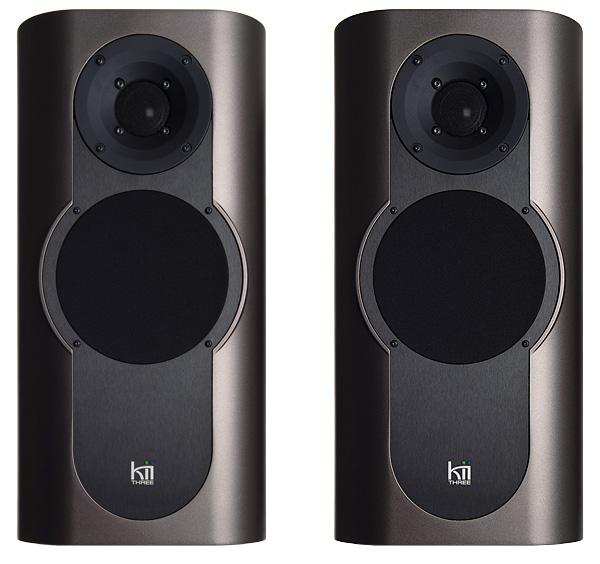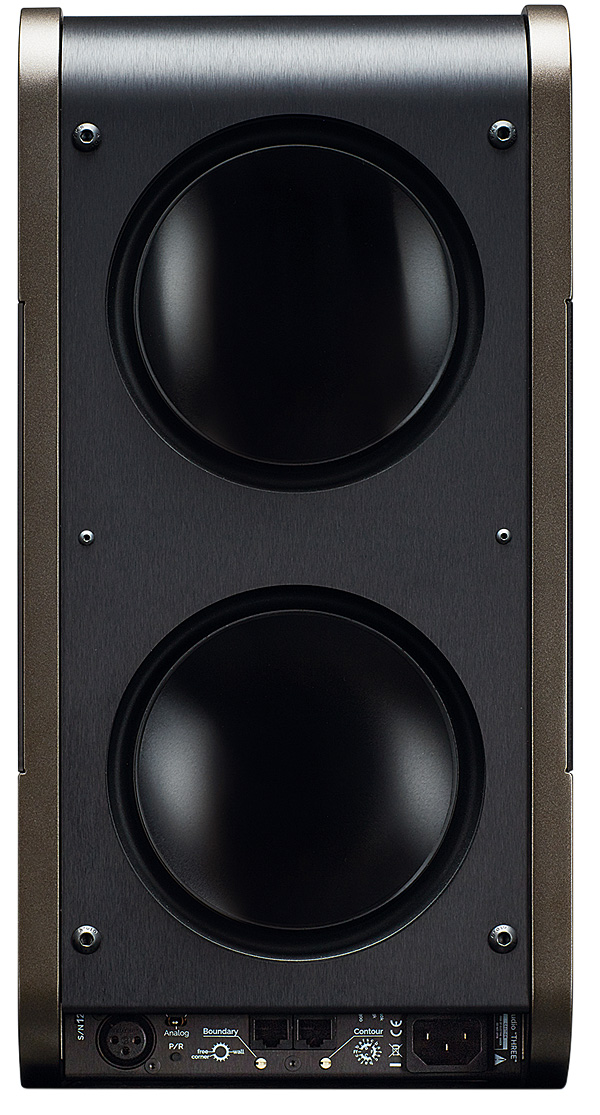Kii Audio THREE loudspeaker

 If the BeoLab 90 wowed you with its tech but daunted you with its size and price, here’s a pint-sized alternative
If the BeoLab 90 wowed you with its tech but daunted you with its size and price, here’s a pint-sized alternative
Kii Audio’s THREE is an exemplar of what can be achieved when the hi-fi industry’s, and hi-fi buyers’, lingering obsession with passive loudspeakers is set aside and a 21st century approach – active operation in conjunction with digital signal processing (DSP) – is adopted instead. In short order we’ve experienced the B&O BeoLab 90 [HFN Dec ’16], the KEF LS50 Wireless [HFN Oct ’17] and now the Kii (pronounced ‘key’) THREE.
Each different to the others, each at a very different price point, but birds of a feather in that all are DSP active designs – and the B&O and Kii strengthen the bond by also incorporating directivity control. Hi-fi’s long, some would say Luddite love affair with the passive loudspeaker is at last under challenge from more than long-term active stalwarts, Meridian.
Complete Package
At a price of £10,990 a pair in its most basic form – £12,480 with controller, £13,475 with controller and stands – the Kii THREE packs a lot into its compact, 400x200x400mm (hwd) cabinet and makes you wonder how many passive speakers at a similar price can possibly justify their cost. With the Kii THREE all you need is a music source, analogue or digital, and you have a complete audio system.
On its front baffle there are two drivers, a 5in bass-mid unit and a 1in dome tweeter with a shallow waveguide that’s unusual in not having continuously curved walls but two coaxial ‘steps’ within the flare which act – somewhat like the diffraction slot in a constant directivity horn – to improve the tweeter’s off-axis behaviour.
This is the passive part of the Kii THREE’s directivity control. The active part comprises four 6.5in bass drivers with dished black-anodised aluminium diaphragms, two located on the sides of the cabinet towards the front baffle, and two on the rear panel firing backwards. Controlled by the onboard DSP, these four drivers radiate different signals to the sides and rear in such a way as to achieve – from 100Hz to 1kHz – a polar pattern similar to that of a cardioid microphone. This has the benefit of reducing the room’s contribution to the sound you hear, while also unifying the spectra of the direct sound and early reflections.

Below 100Hz the THREE reverts to being omnidirectional, as conventional monopole speakers are at low frequencies, which assists with power handling given that the response is extended, again courtesy of the DSP, to below 20Hz. Of course, those four small bass drivers don’t have the displacement capability to provide high output at such low frequencies, so the DSP is again called upon to provide driver excursion protection. This is achieved by a high-pass bass filter with dynamically variable corner frequency, configured to keep the driver movement within safe bounds.
Small Box, Big Power
Each of the six drivers has its own power amplifier, of course. And given that Bruno Putzeys [see interview], designer of the Class D Hypex, Ncore and Mola-Mola amplifiers [HFN Aug ’17], is also a key member of the Kii Audio team, it’s no surprise that these are Ncore modules rated at 250W each.
Crossover filtering is, naturally, also performed in the internal DSP. Fourth-order Linkwitz-Riley slopes are used as Bruno Putzeys considers these optimal. To correct the crossover phase distortion, FIR (finite impulse response) digital filters are added but as these entail a ‘pre-response’ they increase the DSP’s latency to about 90 milliseconds – more than enough to cause lip-sync issues if the audio accompanies a moving picture. To obviate this the THREE can be operated in low-latency mode – latency about 1msec – but this sacrifices the phase correction.
Both analogue and digital inputs are provided via a slim connection and control panel located beneath the two rear drivers. To the left a three-pin female XLR socket provides for both balanced analogue input and balanced AES/EBU digital input, a small three-position switch immediately to its right selecting between R (right channel analogue input), D (digital input) and L (left channel analogue). Note that there are no unbalanced digital inputs (coaxial or optical) and no USB input either. There are two RJ45 sockets for the Kiilink control system – one for Kii’s controller [see boxout, above], if used, and the other to daisy-chain to the second, slave speaker of the pair. Beneath these, two rotary ‘Boundary’ and ‘Contour’ controls provide frequency response variation, the former to correct for LF boundary gain and the latter to tweak the tonal balance to taste. Incidentally, all digital inputs are resampled to the fixed internal sampling rate of 93.75kHz. DSD, of course, is not supported unless you add the Kii CONTROL. A three-pin IEC mains socket completes the connections.
Custom Colours
Kii Audio says little in its literature about the cabinet, giving the impression that much greater design emphasis was put on the THREE’s electronics, but it too is unusual. The front baffle and sides are formed of a painted, one-piece, U-shaped polyurethane moulding, closed by another shaped moulding that forms the back panel and flat panels on the cabinet top and bottom. Two standard paint colours are available for the main moulding: high gloss white and graphite satin metallic. If you’d like the speakers to match your Bentley or have wacky interior design ideas, custom colours can be specified in a choice of high gloss, matt or metallic finishes for a price premium of £1000 per pair.
![]() Audio Dynamite
Audio Dynamite
This is a very clean, open and detailed sounding DSP-governed/active speaker – one that sounds far larger than expected, and is able to deliver serious amounts of clean power without tears, into fairly large rooms. As soon as you set ears upon it, it is obvious that the designer has managed to integrate the multiple drive units very successfully indeed, because the result is a spacious, three-dimensional sound that’s generally seamless from top to bottom.
The Kii Audio THREE’s problem – if you can call it that – is that it fools the listener into thinking it’s actually a much larger loudspeaker, whereupon you begin to judge it more harshly for, if not a lack of bass extension, then its limited physical bass power. This is rather ironic, because it excels in these respects considering how compact a design it actually is.
























































